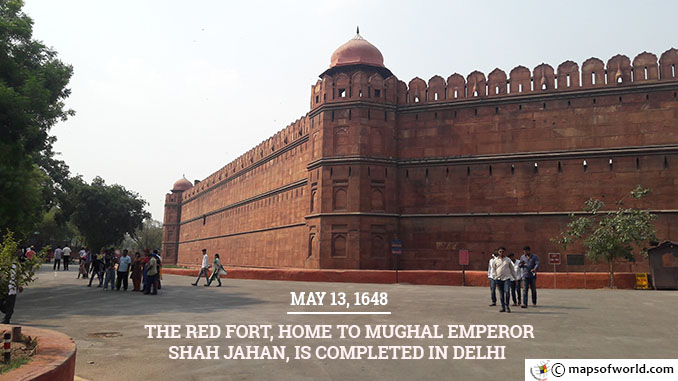Shah Jahan, in a bid to deepen the lasting impression of the Mughal Dynasty on Indian history, achieved a major step in the creation of his legacy on May 13, 1648: the Red Fort, a new palace constructed in Delhi, was completed after 10 years of construction work. The massive sandstone structure on the banks of the River Yamuna, in addition to being a stunning piece of architecture, would serve as the residence of the Mughal Emperors for more than 200 years. Some 120 miles to the southeast of Delhi, Agra was the center of Mughal government when Shah Jahan took control of the empire in 1628. Perhaps stinging from the death of his beloved Mumtaz Mahal — or more likely, looking to secure his holdings in the former Mughal power center of Delhi — the emperor decided to create the new palace adjacent to the existing Salimgarh Fort. Built by Salim Shah Suri in 1546, the comparatively small brick building along the Yamuna River in Delhi was considered to be in an ideal location for a variety of reasons, chief among them a limited number of directions from which an enemy army could launch an attack. Determined to create an imperial residence befitting his vast ambition, Shah Jahan commissioned the Red Fort on May 13, 1638 — giving a nod to the Islamic calendar by starting during the month of Muharram, believed by adherents to be a prosperous time of year. Personally invested in the project, the emperor selected the distinctive sandstone making up the 105-foot-high exterior walls. Within the 255-acre site, Shah Jahan melded a number of design styles — Indian, Persian and European — in order to give the final edifice an air of magnificence exceeded only by his other major construction project, the Taj Mahal. Presiding over the Mughal Empire during one of its most financially abundant eras, the emperor could afford to make the Red Fort into one of the most ornate in the world. The massive open spaces and high ceilings drew the eye, not to mention the exquisite use of marble. Whether a commoner or head of state, guests of Shah Jahan would have found the building breathtaking after its opening on May 13, 1648 — ten years to the day after it was started. Following Shah Jahan’s death in 1666, the Red Fort slowly fell into disrepair. As the riches of the royal family diminished, the silver ceilings were replaced with copper inlays and sold to raise funds. By 1739, when Nadir Shah led the Persians into Delhi and crushed the Mughal armies of Muhammad Shah, the building had experienced a bit of a renaissance — one undone by the Persian sack of the city. The empire continued to decline, finally agreeing to subject itself to the Maratha Empire by treaty in 1752. Though a Mughal remained on the throne until the rebellion of 1857, when Bahadur Shah II fell to British forces, there were no defenses at the storied palace during the uprising. With the Europeans firmly in control afterward, the Red Fort was plundered once again and the internal beauty of the palace demolished — it would be a strictly military location from 1863 on. For the next 140 years, soldiers guarded at least part of the location, first representing the colonial British and then sovereign India beginning in the mid-20th century. Considered a favorite location of the people, citizens of India gather at the Lahore Gate every August 15 to celebrate the nation’s independence. Made a UNESCO World Heritage Site in 2007, a nightly music and light show commemorates the Red Fort’s place in the national story of India. Also On This Day: 1497 – Girolamo Savonarola is excommunicated by Pope Alexander VI. 1787 – The First Fleet, under the command of Captain Arthur Phillip, leaves Portsmouth, England with 11 ships filled with convicts bound for Australia. 1880 – Thomas Edison tests his electric railway for the first time. 1943 – German and Italian troops surrender to Allied armies in North Africa. 1958 – The trademark for Velcro is registered.
May 13 1648 – The Red Fort, Home to Mughal Emperor Shah Jahan, is Completed in Delhi
Shah Jahan, in a bid to deepen the lasting impression of the Mughal Dynasty on Indian history, achieved a major step in the creation of his legacy on May 13,…
530
